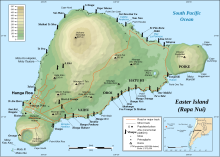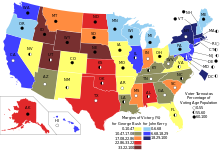27:
65:. For example, coloring a certain nation a color that has a negative connotation in their culture could be counterproductive. Likewise, using assumed skin colors to show racial or ethnic patterns will likely cause offense. It is not possible to always predict the color connotations of every map reader or to avoid negative connotations, but it is helpful to be aware of common color connotations in order to make a map as appealing and understandable as possible.
95:
68:
Cartographers may also choose to pick hues that are associated with what they are mapping. For example, when mapping precipitation, they may choose to use shades of blue or for a map of wildfires they may use yellows, reds, and oranges. Carefully choosing colors ensures that the map is intuitive
57:
is a thematic map in which areas are colored differently to show the measurement of a statistical variable being displayed on the map. The choropleth map provides an easy way to visualize how a measurement varies across a geographic area or it shows the level of variability within a region. In
61:
Displaying the data in different hues can greatly affect the understanding or feel of the map. In many cultures, certain colors have connotations. These connotations lie under a field of study called
53:
Color is a very useful attribute to depict different features on a map. Typical uses of color include displaying different political divisions, different elevations, or different kinds of roads. A
76:
A general rule is that most people can differentiate only between 5-8 different shades of one color. Rather than more than 8 shades of a color, it is best to use multiple colors. Most
69:
and easy to read. This process is referred to as feature association. Also, the cartographer must take into account that many people have
99:
91:
intended for different eyes, or by using the characteristics of the human visual system to make the map look three-dimensional.
287:
77:
58:
addition to choropleth maps, a cartographer should strive to depict colors effectively on any kind of map.
20:
190:
87:
Colors can also be used to produce three-dimensional effects from two-dimensional maps, either by
141:
282:
217:
8:
39:
221:
208:
Brewer, C. (1996). "Guidelines for selecting colors for diverging schemes on maps".
256:
225:
70:
62:
261:
244:
292:
115:
103:
54:
276:
229:
31:
81:
73:, and colors must be used that are easily distinguishable by such readers.
120:
88:
155:
Robinson, A.H. (1967). "Psychological aspects of color in cartography".
47:
26:
94:
84:
to choose from, thus making the process of selecting colors easier.
16:
Differentiating different features of a map using different colours.
274:
154:
80:programs provide users with carefully curated
191:"The right colors makes data easier to read"
242:
46:is the act of choosing colors as a form of
207:
139:
260:
142:"Map Colors - The Role of Colors on Maps"
100:2004 United States presidential election
93:
25:
245:"Color stereoscopic effect cartography"
89:explicit color-coding of the two images
275:
173:
157:International Yearbook of Cartography
188:
13:
14:
304:
178:. Guilford Press. pp. 64–65.
34:using colors to show elevations.
236:
216:(2). Maney Publishing: 79–86.
201:
182:
167:
148:
133:
1:
126:
7:
262:10.3138/K213-2288-7672-U72T
109:
10:
309:
21:Map coloring (mathematics)
18:
288:Visualization (graphics)
230:10.1179/caj.1996.33.2.79
210:The Cartographic Journal
176:Principles of Map Design
19:Not to be confused with
195:Harvard Business Review
255:(1). UT Press: 20–29.
174:Tyner, Judith (2010).
106:
50:to be used on a map.
35:
97:
71:impaired color vision
29:
243:Eyton, J.R. (1990).
189:Lin, Sharon (2014).
222:1996CartJ..33...79B
102:visualised using a
40:cartographic design
30:Topographic map of
107:
36:
300:
267:
266:
264:
240:
234:
233:
205:
199:
198:
186:
180:
179:
171:
165:
164:
152:
146:
145:
140:Matt Rosenberg.
137:
308:
307:
303:
302:
301:
299:
298:
297:
273:
272:
271:
270:
241:
237:
206:
202:
187:
183:
172:
168:
153:
149:
138:
134:
129:
112:
63:color symbolism
24:
17:
12:
11:
5:
306:
296:
295:
290:
285:
269:
268:
235:
200:
181:
166:
147:
131:
130:
128:
125:
124:
123:
118:
116:Choropleth map
111:
108:
104:choropleth map
55:choropleth map
15:
9:
6:
4:
3:
2:
305:
294:
291:
289:
286:
284:
281:
280:
278:
263:
258:
254:
250:
249:Cartographica
246:
239:
231:
227:
223:
219:
215:
211:
204:
196:
192:
185:
177:
170:
162:
158:
151:
143:
136:
132:
122:
119:
117:
114:
113:
105:
101:
96:
92:
90:
85:
83:
82:color schemes
79:
74:
72:
66:
64:
59:
56:
51:
49:
45:
41:
33:
32:Easter Island
28:
22:
252:
248:
238:
213:
209:
203:
194:
184:
175:
169:
160:
156:
150:
135:
86:
75:
67:
60:
52:
44:map coloring
43:
37:
283:Cartography
121:ColorBrewer
277:Categories
127:References
48:map symbol
163:: 50–61.
110:See also
218:Bibcode
293:Color
98:The
257:doi
226:doi
78:GIS
38:In
279::
253:27
251:.
247:.
224:.
214:33
212:.
193:.
159:.
42:,
265:.
259::
232:.
228::
220::
197:.
161:7
144:.
23:.
Text is available under the Creative Commons Attribution-ShareAlike License. Additional terms may apply.

